Introduction
The first global assessment of the 100 most important questions for biodiversity conservation included the question ‘What factors shape (in)tolerance of the presence and activities of wild animals, especially where those animals induce human–wildlife conflict?’ (Sutherland et al., Reference Sutherland, Adams, Aronson, Aveling, Blackburn and Broad2009). As framed, the question made it clear that not only the characteristics of so-called human–wildlife conflict are important, but also the identification of conditions and animal behaviour that lead to such situations. Globally, many studies have since examined human–carnivore interactions, to identify aspects that can help reduce or eliminate negative interactions (Nyhus, Reference Nyhus2016). Carnivores dominate in the global literature on interactions of people and wildlife, and mitigation is becoming increasingly urgent (Inskip & Zimmermann, Reference Inskip and Zimmermann2009; Nyhus, Reference Nyhus2016). This urgency is fuelled by damage to property, human injuries and fatalities, and retaliatory killings of species of global conservation concern (Karanth & Madhusudan, Reference Karanth, Madhusudan, Terborgh, van Shaik, Rao and Davenport2002; Treves et al., Reference Treves, Wallace, Naughton-Treves and Morales2006). Identification of the conditions that lead to negative interactions is often confounded by a mismatch between people's perceptions and the actual ecology and behaviour of wildlife species, and by socio-cultural aspects of conflict situations (Suryawanshi et al., Reference Suryawanshi, Bhatnagar, Redpath and Mishra2013; Anand & Radhakrishna, Reference Anand and Radhakrishna2017; Karanth et al., Reference Karanth, Shivangi and Weinthal2019). The problem of potentially mismatched perceptions and realities is not easy to solve because most studies utilize questionnaire surveys of people living near, or experiencing interactions with, carnivores, thus relying extensively on people's perceptions (Treves et al., Reference Treves, Wallace, Naughton-Treves and Morales2006; Kansky & Knight, Reference Kansky and Knight2014). In addition, there is a paucity of studies in areas where most people are affected by negative interactions with wildlife, and on the species most frequently involved in such situations (Can et al., Reference Can, D'Cruze, Garshelis, Beecham and Macdonald2014; Anand & Radhakrishna, Reference Anand and Radhakrishna2017). Bears have a global distribution, with multiple species involved in negative interactions with people, thus providing an opportunity to address this issue (Can et al., Reference Can, D'Cruze, Garshelis, Beecham and Macdonald2014).
Bears occur on all four major continents, but literature on their ecology and interactions with humans focuses primarily on two North American species (the American black bear Ursus americanus and the brown bear Ursus arctos; Can et al., Reference Can, D'Cruze, Garshelis, Beecham and Macdonald2014). In India, the sloth bear Melursus ursinus, categorized as Vulnerable on the IUCN Red List (Dharaiya et al., Reference Dharaiya, Bargali and Sharp2016), frequently attacks people. These bears cause hundreds of grievous injuries and fatalities annually (Quigley & Herrero, Reference Quigley, Herrero, Woodroffe, Thirgood and Rabinowitz2005; Can et al., Reference Can, D'Cruze, Garshelis, Beecham and Macdonald2014), yet few studies have addressed this problem. Habitat loss and deterioration, and the natural aggressiveness of the species, are thought to exacerbate negative interactions with humans (Islam et al., Reference Islam, Uddin, Aziz, Muzaffar, Chakma and Chowdhury2013; Yoganand et al., Reference Yoganand, Rice, Johnsingh, Johnsingh and N.2013). Human–sloth bear interactions have been studied in several protected areas (including buffer zones) across the species’ range, where bears encounter people from traditional communities that live in and near forests and subsist on forest resources (Bargali et al., Reference Bargali, Akhtar and Chauhan2005; Debata et al., Reference Debata, Swain, Sahu and Palei2017; Dhamorikar et al., Reference Dhamorikar, Mehta, Bargali and Gore2017; Lamichhane et al., Reference Lamichhane, Persoon, Leirs, Poudel, Subedi and Pokheral2018; Singh et al., Reference Singh, Sonone and Dharaiya2018). Sloth bears are largely myrmecophages (ant and termite eaters) and rarely access anthropogenic food sources such as crops (Joshi et al., Reference Joshi, Gershelis and Smith1997; Bargali et al., Reference Bargali, Akhtar and Chauhan2004; Yoganand et al., Reference Yoganand, Rice and Johnsingh2005). Negative interactions with humans have increased where bears live outside protected areas, and where food and cover for bears have deteriorated because of human activity (Yoganand et al., Reference Yoganand, Rice, Johnsingh, Johnsingh and N.2013; Dharaiya et al., Reference Dharaiya, Bargali and Sharp2016). Understanding sloth bear ecology in different conditions can inform responses when negative interactions arise (Bargali & Sharma, Reference Bargali, Sharma, Sharma, Kulshreshta and Rahmani2013; Yoganand et al., Reference Yoganand, Rice, Johnsingh, Johnsingh and N.2013; Can et al., Reference Can, D'Cruze, Garshelis, Beecham and Macdonald2014; Dharaiya et al., Reference Dharaiya, Bargali and Sharp2016).
Following media reports of sloth bear attacks on people in the tourism-dominated town of Mount Abu in southern Rajasthan, India, we initiated a study to investigate the situation. It became evident that the situation was unique, with bears entering the town from a surrounding reserve that has the highest known density of sloth bears in the state (Bargali & Sharma, Reference Bargali, Sharma, Sharma, Kulshreshta and Rahmani2013). As there had been no previous studies of sloth bears in Mount Abu, we aimed to obtain baseline information on the attitudes and experiences of residents who interacted with sloth bears. Our objectives were to examine the residents’ attitudes towards sloth bears, to document their knowledge of bear ecology, and to identify the causes of human–sloth bear interactions. We also evaluated independent data on attacks by bears and analysed reported sightings of bears in relation to land cover and features associated with bear ecology, to identify factors that influence bear presence in Mount Abu and to crosscheck the information obtained through the questionnaire surveys. Thus, by combining information from several sources we aimed to identify any factors contributing to negative human–bear interactions in Mount Abu, and to use these insights to help de-escalate or resolve the problem.
Study area
We conducted our study during January–May 2019 in Mount Abu town in southern Rajasthan, India (Fig. 1). The town is located atop the world's oldest fold mountains, the Aravallis, at the highest point in the state (1,722 m altitude), and is entirely surrounded by Mount Abu Bear Sanctuary. This protected area has the highest sloth bear density in the state (Bargali & Sharma, Reference Bargali, Sharma, Sharma, Kulshreshta and Rahmani2013). The town covers 45 km2 within subtropical evergreen and subtropical wet hill forests (Champion & Seth, Reference Champion and Seth1968). There are three distinct seasons based on temperature and rainfall: summer (March–June), monsoon (July–October) and winter (November–February). In the most recent census the resident population of the town was 22,943 (Office of the Registrar General & Census Commissioner, India, 2011). Its scenic setting amid forested hills and its proximity to several popular Hindu and Jain temples make Mount Abu one of the most visited locations in the state of Rajasthan, with > 1.5 million tourists visiting annually (Ferguson & Co., 2019).
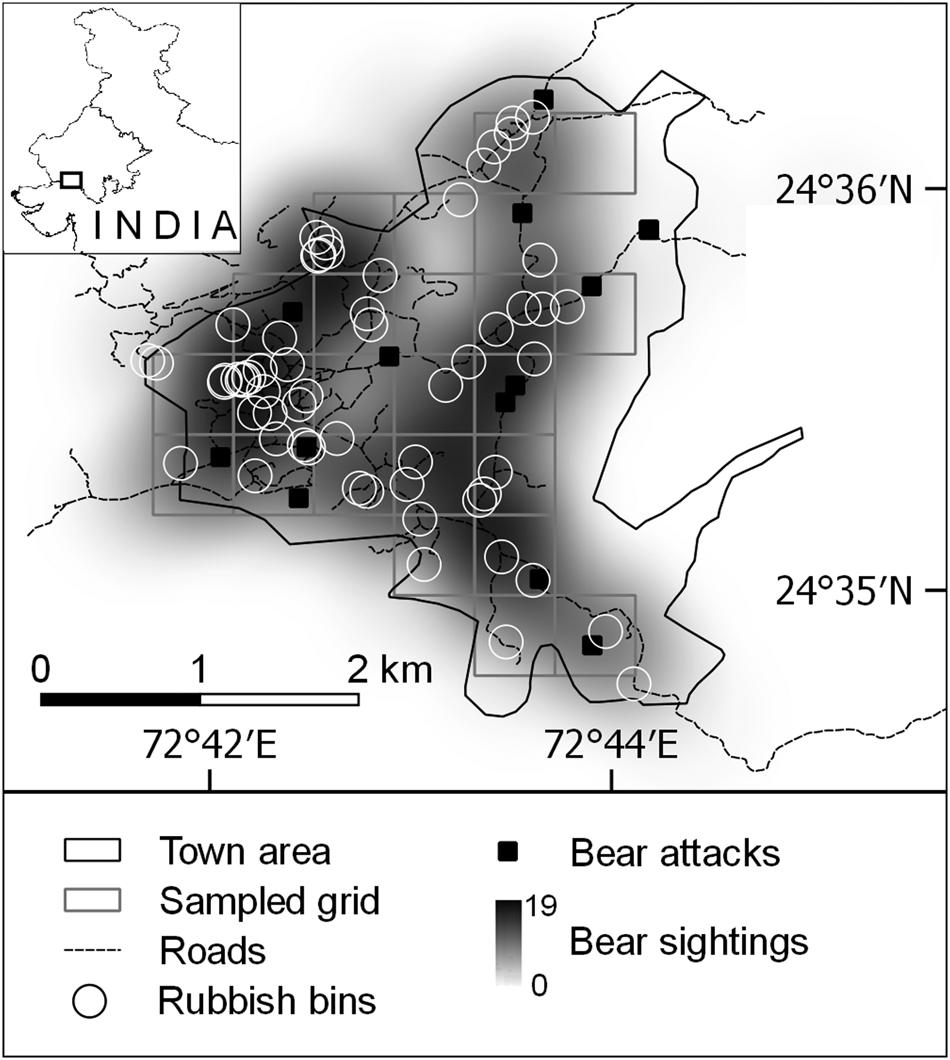
Fig. 1 Location of Mount Abu town in India (inset), sampled grid cells in town, heat map of sloth bear Melursus ursinus sightings during the 2 years prior to the study (provided by 241 residents), major roads, locations of bear attacks (provided by the Rajasthan Forest Department) and rubbish bins.
Methods
We overlaid a digital boundary of Mount Abu town (Rajasthan Forest Department, 2019) with a grid of 500 × 500 m cells, and visited all accessible grid cells and those with permanent human habitation. In each cell, we selected 11 people to be interviewed. To ensure that we included a variety of people across different ages, genders, occupations and educational levels, we approached potential interviewees at different locations (e.g. hotels, private houses, business establishments, schools and farmlands).
Residents’ attitudes towards bears
We assessed residents’ attitudes towards sloth bears and their understanding of bear ecology using a semi-structured questionnaire with a combination of closed and open-ended questions (Supplementary Material 1). We first tested the questionnaire with 25 people to identify ambiguous or leading questions, especially when rendered in the locally spoken languages of Hindi or Rajasthani, and removed or modified any problematic questions. Respondents completing the questionnaire during the test phase were not included in subsequent interviews. We measured attitudes towards sloth bears by scoring six questions framed to determine residents’ attitudes towards bears in their area, with scores being favourable (+1), neutral (0) or negative (−1) for each question. We measured attitudes as a composite of six questions rather than one direct question because Rajasthanis generally have strongly positive attitudes towards wildlife because of religious beliefs and social norms (Karanth et al., Reference Karanth, Shivangi and Weinthal2019), and answers to a single question would probably be biased towards existing norms. We reduced confirmation and acquiescence bias by having an equal number of positive and reverse questions and eliminated carelessness bias by administering questionnaires in person (Weijters et al., Reference Weijters, Baumgartner and Schillewaert2013; Suárez-Alvarez et al., Reference Suárez-Alvarez, Pedrosa, Lozano, García-Cueto, Cuesta and Muñiz2018). Open-ended questions addressed residents’ personal experiences with bears, limited to those that took place within the last 2 years, to minimize recall errors. We asked about the locations, time of day, and number of bears encountered, and locations of known attacks on people. We determined the geographical coordinates of all attack locations using a GPS. Questions also assessed respondents’ perceptions of bear ecology. We asked about respondents’ thoughts on the principal reason bears enter Mount Abu, what bears forage for, and why bears attack people. We recorded the respondents’ age, gender, education status (six categories), and occupation (nine categories), to examine whether attitudes towards sloth bears were influenced by these factors.
Secondary data on bear attacks
To verify respondents’ views of trends in sloth bear attacks, we collated cases of bear attacks on people documented by the Forest Department, Government of Rajasthan, and results from an online search using the phrases ‘Mount Abu’, ‘sloth bear’, and ‘attack’. We excluded social media content with poor verifiability of location and date. Using a GPS, we obtained geographical coordinates of Forest Department records for mapping.
Influence of land-cover variables on sloth bear sightings
Sloth bear presence is influenced by multiple variables including availability of food and water, and vegetation cover (Dharaiya et al., Reference Dharaiya, Bargali and Sharp2016). In addition, within a town, we presumed that bear movement was limited by built-up areas but facilitated by roads. We therefore measured built-up area (m2), vegetation cover (m2), road length (m), and open water availability (m2) in each grid cell using the most recent images on GoogleEarth Pro 7.3.2 (Google, Mountain View, USA). Because responses during the trial questionnaire suggested that sloth bears visit rubbish bins for food, we also mapped all rubbish bins. Variance inflation factors for all variables were < 4 (range 1.09–3.71), suggesting that levels of autocorrelation were acceptable, and we modelled untransformed variable measures against pooled bear sightings at the grid cell level.
Statistical analyses
We totalled the number of respondents providing answers to questions relating to experiences with bears, time of day when experiences occurred, primary reasons why respondents believed bears were entering Mount Abu, and why they thought bears attack people. We visualized these as descriptive bar graphs. We determined the geographical locations of all instances of bear sightings, using a GPS (n = 217), and generated a heat map using QGIS 2.12.0 (QGIS Development Team, 2012) of the number of bears sighted, to examine the spatial distribution of bear presence in Mount Abu. We also included locations of rubbish bins on this map.
For each respondent, we calculated the mean attitude score, which varied between +1 (entirely positive attitude towards bears) and −1 (completely negative attitude towards bears). We used recursive partitioning to examine which factors (age, gender, education status, occupation) influenced residents’ attitudes towards bears. Recursive partitioning uses classification and regression trees to create binary decision trees that identify variables most important in determining the outcome of a choice (Strobl et al., Reference Strobl, Malley and Tutz2009). We first generated a classification tree with all variables using the rpart package in R 3.6.1 (Therneau & Atkinson, Reference Therneau and Atkinson2019) to assess contributions of all variables to the measured attitudes. The resulting models were complex (Supplementary Figs 1 & 2), and we identified significant variables (P < 0.05) by generating a non-parametric conditional inference tree via recursive partitioning with the R package party (Hothorn et al., Reference Hothorn, Hornik, Strobl and Zeileis2019) for final interpretation.
We summed bear attack information from secondary sources and compared these data with information obtained from the residents of Mount Abu. We also included information from the city municipality on the number of vehicles entering the city annually, to visualize the scale of tourism. A Fisher's exact test of the number of seasonal attacks, provided separately by the Forest Department of Rajasthan, showed that the two data sources had similar inter-seasonal variation (P = 0.42). To assess whether bear attacks had a seasonal bias, we totalled attacks per season from both sources and performed a Pearson's χ 2 goodness-of-fit test on the pooled data.
We independently assessed the factors most important for bear sightings using generalized additive modelling and the information-theoretic approach by regressing numbers of bear sightings per grid cell against the six short-listed variables. We used generalized additive modelling to avoid assumptions regarding linear relationships. Data on bear attacks were inadequate to run similar analyses. We created a list of a priori models, including a full model (with all variables) and a null model (assuming observed variations to be random) and used the Akaike information criterion corrected for small sample sizes (AICc) to determine the most parsimonious model. We used the R package gam for modelling (Hastie, Reference Hastie2018) and the R package MuMIn for model selection metrics (Bartoń, Reference Bartoń2019). We used a reduction of two AICc units to signify improvement between competing models (Burnham & Anderson, Reference Burnham and Anderson2002). We ran full models both with the grid cell number as a spatial variable and without, to assess any potential influence of grid cell identity. There was poor support for the full model with grid cell identity (4.2 AICc units higher than the full model without grid identity; see Results), and we therefore excluded grid cell numbers in other models. We generated plots of the component smooth functions against the scale of linear predictors to assess the directionality and nature of relationships. Results of generalized additive modelling were compared against respondents’ opinions regarding factors influencing bear sightings.
Results
Residents’ attitudes towards bears
Respondents (n = 241) encountered sloth bears widely across Mount Abu (Fig. 1). Residents largely had negative attitudes towards sloth bears, with considerable model complexity when all the variables were included (Supplementary Fig. 1). Considering all variables collectively, residents’ attitudes were shaped by gender and age (P < 0.001), with women and younger men (< 36 years of age) having the most negative attitudes towards bears (Fig. 2). Considering other variables individually, measured attitudes showed little variation across education levels (Supplementary Fig. 2; Kruskal–Wallis χ 25 = 8.55, P = 0.13). However, attitudes varied considerably across occupations, with home-makers (all women interviewed) having the most negative attitudes, people working in a business establishment having the most positive, and farmers and students having the smallest range of attitudes scores (Supplementary Fig. 2; Kruskal–Wallis χ 25 = 24.47, P = 0.0009). No human fatalities caused by bear attacks, or retaliatory action against sloth bears, were reported.
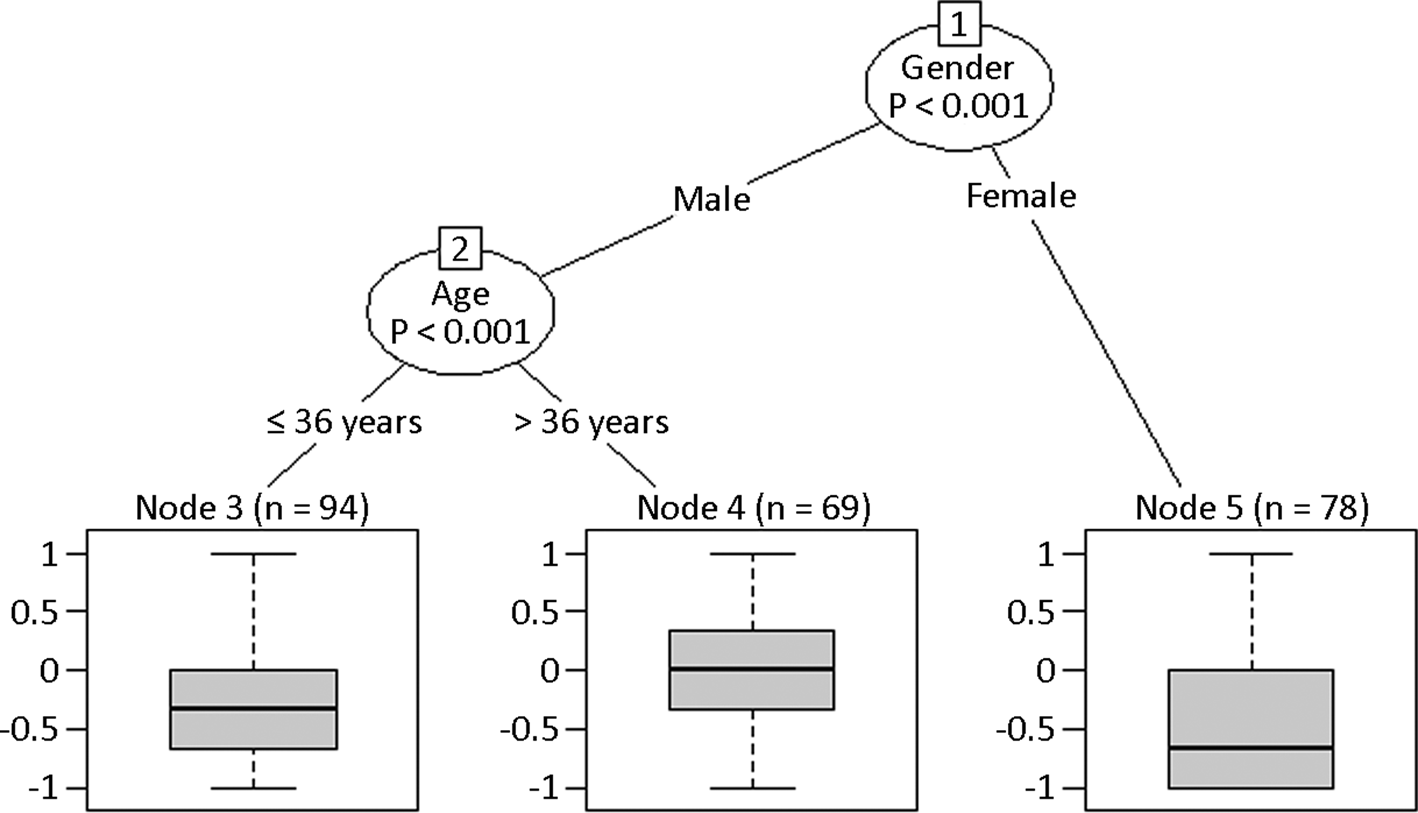
Fig. 2 Non-parametric regression tree identifying factors affecting measured attitudes of 241 residents of Mount Abu town, Rajasthan, India towards sloth bears. Measured attitudes, with +1 indicating completely positive attitude and −1 indicating completely negative attitude towards bears, are summarized in box plots.
Bear attacks on people were reported to occur most frequently on roads and were widespread across the town (Fig. 1). Most residents reported increases in bear encounters and attacks within the last 2 years (Fig. 3a). A majority of respondents had encountered bears in the week before being interviewed, with most encounters occurring between 18.00 and 24.00 (Fig. 3b,c). Most respondents believed that bears entered Mount Abu to forage on rubbish, and that access to the town was facilitated by the fact that it is surrounded by forests (Fig. 4a). According to the interviewees, bears primarily seek food waste from hotels, and sweets in rubbish (Fig. 4c). Respondents indicated that bears attacked when they were surprised by an encounter with people, or when they had cubs (Fig. 4b).
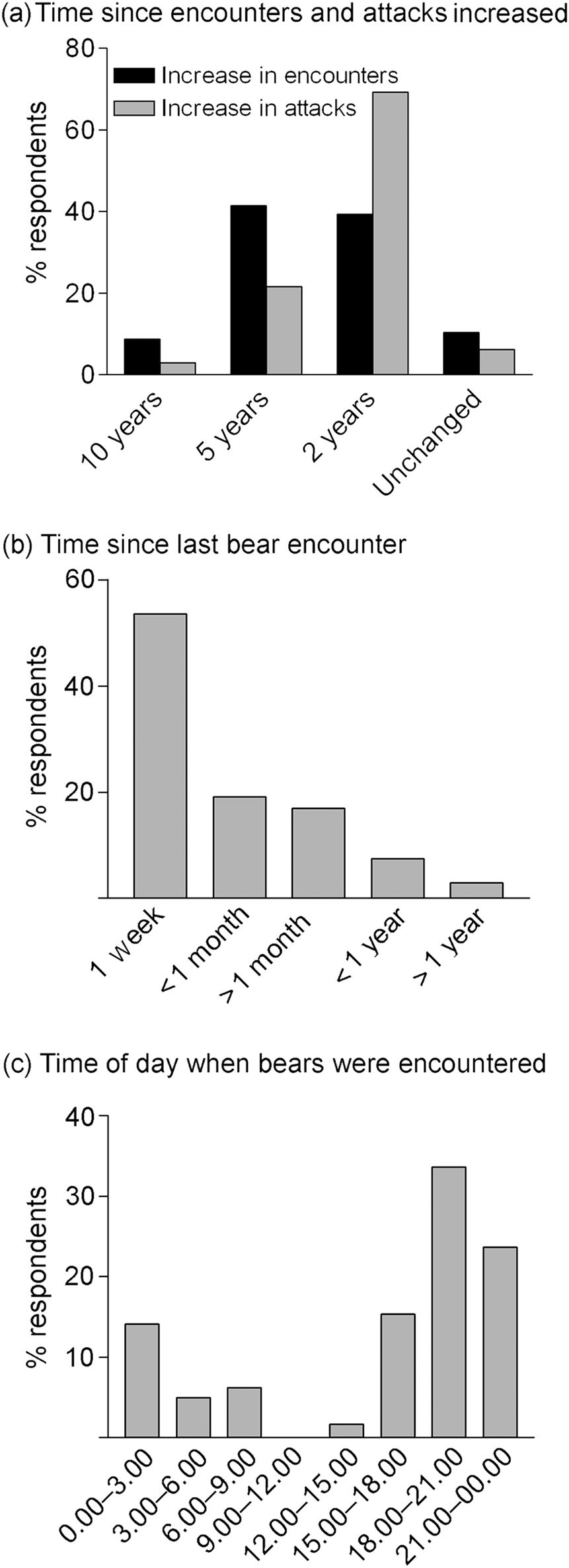
Fig. 3 Experiences of 241 residents with sloth bears inside Mount Abu town, Rajasthan, India. Bar graphs show interviewees’ responses regarding (a) the time since bear encounters and attacks increased, (b) time since their last personal interaction with bears, and (c) the time of day they encountered bears.
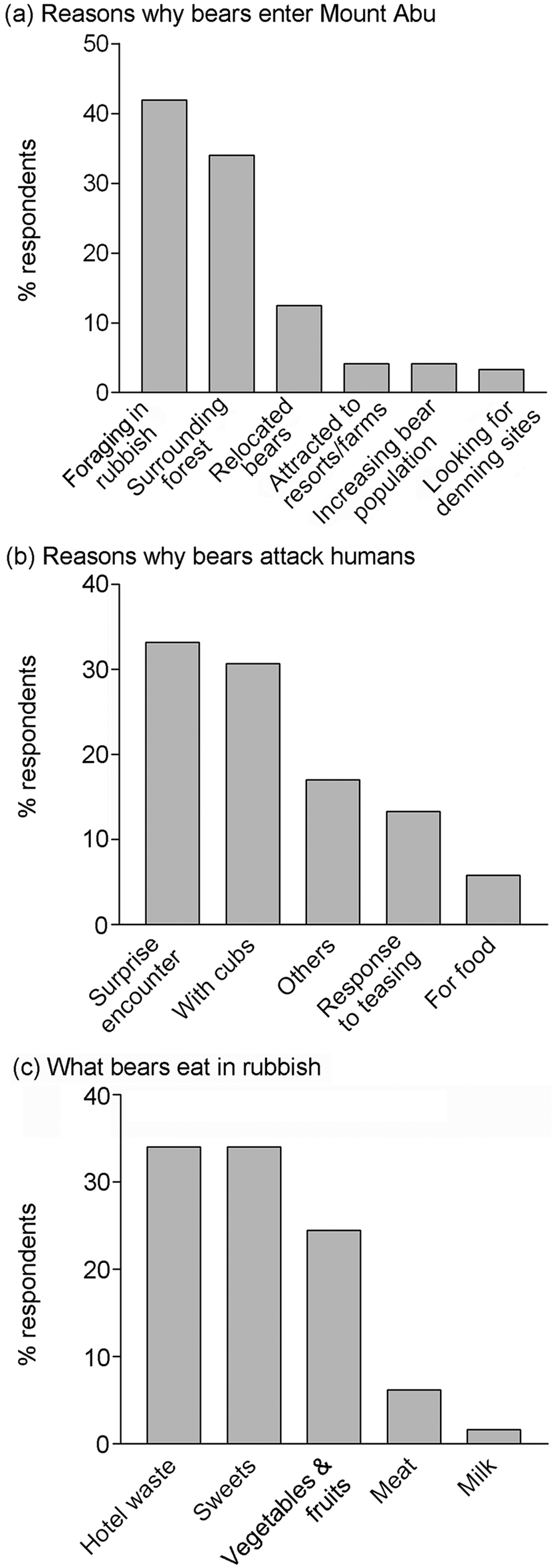
Fig. 4 Perceptions of 241 residents of Mount Abu town, Rajasthan, India, regarding (a) the ecology of sloth bears, particularly reasons why bears enter Mount Abu, (b) reasons why bears attack humans, and (c) what they seek in rubbish.
Secondary data on bear attacks
Forest Department records provided data on 19 attacks in 13 locations that were distributed widely across the town (Fig. 1). Secondary data indicated a sharp increase in bear attacks during 2018–2019, and an exponential increase in tourism during 2016–2018 (Fig. 5). There was no seasonal trend in the number of bear attacks on people (χ 22 = 2.8, P = 0.24).
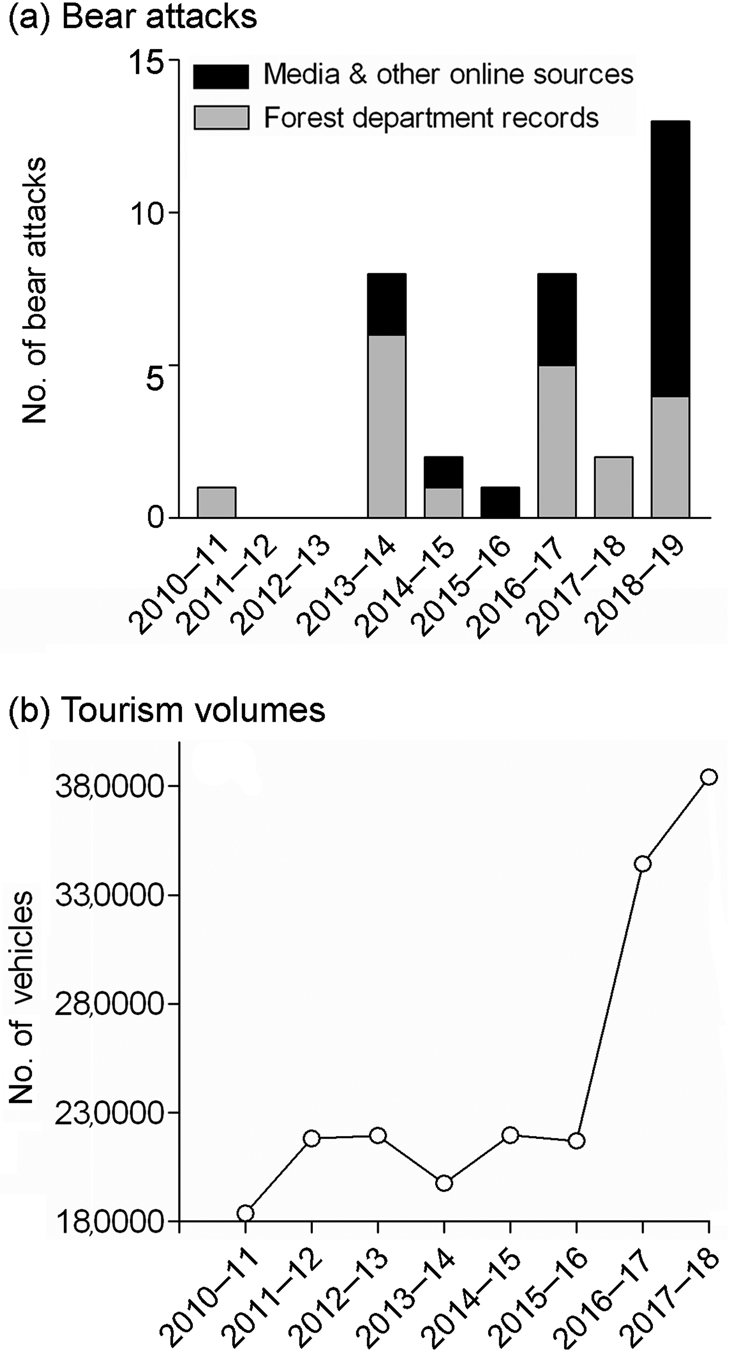
Fig. 5 (a) Number of sloth bear attacks in Mount Abu town, Rajasthan, India, on humans as reported in two secondary sources, and (b) annual tourism volumes represented by the number of vehicles entering the town. Time periods follow the financial year in India (1 April–31 March).
Factors influencing bear sightings
Results of generalized additive modelling indicated the number of rubbish bins to be the most important factor affecting the number of bear sightings per grid cell (model weight = 0.955; 7.67 AICc units better than the subsequent model; Table 1), with a linear, positive effect (Supplementary Fig. 3). There was poor support for built-up areas affecting bear sightings (improvement of 2.8 AICc units over the null model, but worse than the full model by 19.7 AICc units; Table 1; Supplementary Fig. 3). The effect of road length was significant in individual models (Table 1), with a strong non-linear effect of bear sightings declining where road length exceeded 1,000 m (Supplementary Fig. 3). Road length did not feature in top models but adding road length to built-up area improved the model by 8.2 AICc units, suggesting that the effect was not trivial (Table 1). Vegetation cover and water availability did not strongly affect bear sightings, but relationships for both were non-linear, suggesting complex associations (Supplementary Fig. 3).
Table 1 Multi-model statistics to assess factors affecting grid cell-level sloth bear sightings in Mount Abu town, Rajasthan, India, using generalized additive modelling. Statistics include Akaike information criteria corrected for small sample sizes (AICc), difference between the best model and the respective model (ΔAICc), and individual model weights.
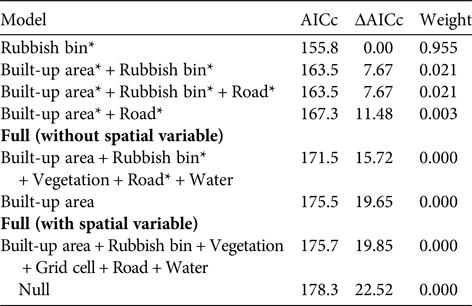
*P < 0.05.
Discussion
Sloth bear sightings in Mount Abu were ubiquitous. Most respondents had encountered bears during the week prior to our survey, suggesting that bear presence was common. Respondents’ perception that bear attacks had increased in the 2 years prior to the interviews was supported by secondary information. Secondary information also showed that bear attacks occurred across the entire town and with similar frequency across seasons. In addition, both respondents and generalized additive modelling identified rubbish bins as the primary attraction for bears. This is a novel situation; sloth bears have not previously been associated with rubbish and their regular presence inside a town with such a high footfall of tourists and residents is unprecedented. That no human fatalities have occurred despite such frequent bear–human encounters is fortunate, and the absence of retaliatory action despite the increasing number of attacks on people is remarkable.
Respondent's attitudes and knowledge of bear ecology
Some of our findings match reports elsewhere, with respondents reporting encounters with bears mostly during late evenings and up to midnight, and women's attitudes towards bears being more negative than those of men (Debata et al., Reference Debata, Swain, Sahu and Palei2017; Dhamorikar et al., Reference Dhamorikar, Mehta, Bargali and Gore2017). Past studies included interviews with people dependent on forest produce whose activities overlapped with peak activity times of sloth bears, leading to increased interactions (Joshi et al., Reference Joshi, Smith and Gershelis1999; Yoganand et al., Reference Yoganand, Rice and Johnsingh2005). In Mount Abu, residents reported encountering bears when they returned home from work. That women have more negative attitudes towards sloth bears has previously been associated with their role as the primary collectors of forest produce (Dharaiya et al., Reference Dharaiya, Bargali and Sharp2016). In Mount Abu all women interviewed were home-makers and their attitudes probably resulted from concern for their family's safety, which is common in communities that experience continuous bear presence (Røskaft et al., Reference Røskaft, Händel, Bjerke and Kaltenborn2007). Older men had more positive attitudes towards bears, possibly because they were more used to bear presence (Johansson et al., Reference Johansson, Støen and Flykt2016). Our analyses show that the reasons underlying residents’ attitudes towards sloth bears in Mount Abu are complex, but will nevertheless help identify groups of people whose participation will be key in planning to reduce negative interactions.
In Mount Abu education level did not affect attitudes, with uneducated residents having similar attitudes to people with various levels of education (Supplementary Fig. 2). This is similar to other areas with conflict situations where education does not significantly influence attitudes (Baruch-Mordo et al., Reference Baruch-Mordo, Breck, Wilson and Broderick2011). There is, however, increasing evidence that planned environmental education can help improve people's attitudes towards bears (Baruch-Mordo et al., Reference Baruch-Mordo, Breck, Wilson and Broderick2011; Espinosa & Jacobson, Reference Espinosa and Jacobson2012). We propose that such education programmes be developed and implemented in Mount Abu to help reduce bear attacks on people and to ensure that negative attitudes do not escalate into retaliatory action.
The utility of secondary data
We were unable to obtain adequate data for analysis of spatial factors associated with bear attacks on people, but visualizations suggest that roads are an important factor (Fig. 1). Both respondents’ views and secondary information suggested that bear attacks, although probably increasing, are not at levels where residents or authorities are alarmed. Secondary information showed that bear attacks occurred with similar frequency across all seasons, suggesting that sloth bears occur in Mount Abu throughout the year. In contrast, sloth bear attacks inside protected areas have strong seasonal biases associated with food availability and human use of forest areas (e.g. Bargali et al., Reference Bargali, Akhtar and Chauhan2005; Singh et al., Reference Singh, Sonone and Dharaiya2018). In areas with increased human activity and habitat disturbance, such as along narrow habitat corridors, bear attacks did not have a seasonal bias, probably because of continued interactions with humans (Dhamorikar et al., Reference Dhamorikar, Mehta, Bargali and Gore2017). This is similar to the situation in Mount Abu, except that the situation is reversed, with bears entering the town rather than humans entering bear habitat. Awareness programmes aiming to minimize bear–human interactions along roads during the late evening and night could help limit injuries to people, particularly as respondents indicated that attacks happened in the context of chance encounters that surprised the bears.
Factors influencing bear sightings inside Mount Abu
Respondents linked bear sightings to availability of rubbish rather than to other potential factors, and generalized additive modelling, which included several variables that respondents did not mention, also independently identified rubbish bins as primary attractants to bears (Table 1). Our analyses indicate that the response variables chosen, although novel in the study of sloth bear ecology, helped explain variations in the number of bear sightings at grid-cell level. There is growing interest in using empirically defensible methods to evaluate factors affecting the use of landscapes by sloth bears (Srivastha et al., Reference Srivastha, Puri, Kumar, Jathanna and Karanth2017), and our study adds to this sparse literature.
Respondents almost unequivocally suggested that food waste from hotels catering to the tourism industry attracted bears into the city. Respondents also indicated that sloth bears searched for sweet foods, similar to their habit in the wild where they seek out sugar-rich foods (e.g. honey and ripe fruits; Yoganand et al., Reference Yoganand, Rice, Johnsingh, Johnsingh and N.2013). Multiple lines of evidence showed accessible rubbish to be the primary attractant for sloth bears in Mount Abu. Sloth bears in the wild adapt to changing conditions by shifting to different foods (Joshi et al., Reference Joshi, Gershelis and Smith1997; Yoganand et al., Reference Yoganand, Rice and Johnsingh2005), but our study provides the only known instance of this species foraging for human-generated rubbish within an urban area. Bears can become dependent on rubbish and may modify their behaviour in a way that can exacerbate conflict situations (Breck et al., Reference Breck, Lance and Seher2009; Cozzi et al., Reference Cozzi, Chynoweth, Kusak, Çoban, Ozgul and Şekercioğlu2016). It is therefore vital that a long-term solution to waste disposal in Mount Abu is found, to help alleviate, or resolve, the increasing negative interactions between people and bears. Bear-proof rubbish containers could be an effective solution and have been shown to reduce the intensity of conflict situations elsewhere (Johnson et al., Reference Johnson, Lewis, Lischka and Breck2018).
Conservation implications
Our findings show the residents of Mount Abu to be reliable informants who are knowledgeable about sloth bear ecology and behaviour. They are thus likely to be attentive participants in conservation actions to help alleviate this potentially escalating conflict. We excluded hoteliers as respondents because the majority of owners were not residents of Mount Abu town, but some of the respondents worked in hotels and resorts. However, hotels are a primary stakeholder given the impact of tourism-generated rubbish. Any waste management plan will need to include hoteliers as stakeholders.
We echo previous calls (Can et al., Reference Can, D'Cruze, Garshelis, Beecham and Macdonald2014; Dharaiya et al., Reference Dharaiya, Bargali and Sharp2016) for improved geographical coverage of studies on sloth bear ecology and on the attitudes of people with whom they share spaces, to facilitate a holistic understanding of how this Vulnerable species interacts with humans. It is important that, wherever possible, such studies demonstrate the reliability of measures of attitudes and other information obtained from respondents. This is essential, to ensure that factors contributing to conflict situations can be reliably identified and that conservation planning includes actions on which stakeholders can agree. Our findings could help de-escalate or eliminate the conflict situation in Mount Abu, and prevent exacerbation of the conflict and retaliation against sloth bears.
Acknowledgements
This research did not receive grants from any funding agency or commercial or not-for-profit sectors. We thank B. Kiri (District Forest Officer, Rajasthan Forest Department) for providing information on cases of conflicts involving bears registered with the department; the Mount Abu municipality for information on the number of vehicles entering the town annually; Sanjay for assistance with field work; H.S. Bargali, Y.V. Bhatnagar, K. Mehta and two anonymous reviewers for their critiques.
Author contributions
Study design: all authors; field work: UP; data analysis: KSGS, VKK; writing: KSGS; revisions: all authors.
Conflicts of interest
None.
Ethical standards
The work abided by the Oryx guidelines on ethical standards, and the questionnaire and study methods were approved by the Institutional Animal Ethics Committee of the Department of Zoology, Mohanlal Sukhadia University, Rajasthan, prior to the study.







